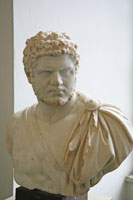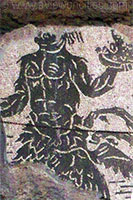The Baths of Caracalla was the largest bath complex in the world when it was completed in 217 AD, during the reign of Emperor Caracalla. The baths were functional for over 300 years.


It is a complex of not only having baths, but also library, meeting rooms, garden, sauna, pools, etc. Hence, the scale is enormous; 228 m long, 116 m wide and 38.5 m high and it can accommodates around 2000 people at a time. The centre of the bath alone is even larger than St. Peter’s Basilica in Vatican City.
The red-brick ruins of the Baths of Caracalla are situated southeast of ancient Rome's center. The baths were enormous buildings, with huge frescoed vaults covering the massive rooms. This huge 11 hectare (27 acre) large complex housed bathing facilities could accommodate more than 1600 people.
Construction of the Baths of Caracalla started in 212 AD and the complex was completed five years later. It was built during the reign of Emperor Caracalla whose official name was Marcus Aurelius Antoninus, hence the original name of the baths, Thermae Antoninianae. For the history, Caracalla Emperor is a cruel, terrifying ruler of Rome. To clean off his cruel and dirty hands and to reverse his failing image, he built this bath for the people. Over 16 000 workers worked for the construction of the building and it took only four years. Another interesting and remarkable breakthrough in this project is the efficient water heating system called as hypocaust


Bust of Caracalla Mosaic decoration
The emperor was nicknamed Caracalla for a Gallic tunic he used to wear, but this name was never officially used. Caracalla is infamous for killing his more popular brother Geta. He is also known for his decision to offer citizenship to all free inhabitants of the Roman Empire, mainly to increase the income from taxes. Bathing in the Roman Era--At a time when Rome's crowded tenements had few sanitary facilities, the more than 50 public baths in Imperial Rome played an important part in Roman society. Not only did it improve the cleaneliness and health of its citizens, but the thermae were also places where Romans came to socialize, gossip and relax. The ritual of bathing was a long process, starting with a hot bath in the calidarium. Next up was the lukewarm tepidarium, followed by the cold frigidarium. Then followed a swim in the natatio, an open air swimming pool. Leisure Center--The Baths of Caracalla was more than a mere bathing house; it was actually a multifunctional leisure center and also housed gymnasiums, libraries, gardens, art galleries, restaurants and even brothels. The Baths of Caracalla was known for its rich interior which featured marble seats, mosaic covered walls and floors as well as fountains and statues. Water Distribution--A complex water distribution system ensured a constant flow of water from the Aqua Marcia aqueduct. Below the main buildings were two levels, the upper one was used for services and heating the water, the lower one was used for water drainage. The baths were fully functional until 537 AD when Goths destroyed the aqueduct,
Decay--Neglection, looting and an earthquake turned this great architectural complex into ruins. But even these ruins continue to impress visitors thanks to their sheer size and magnificence.
No comments:
Post a Comment